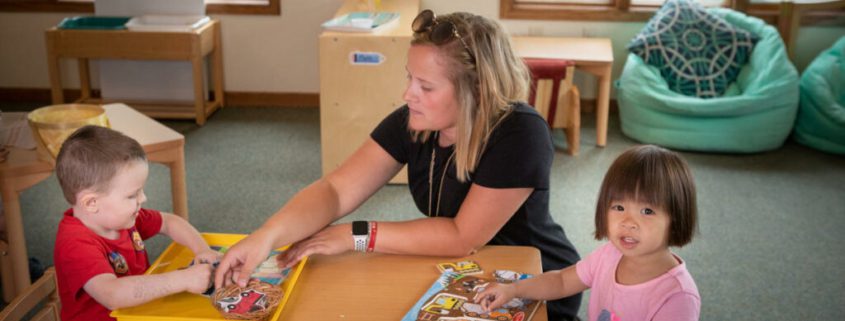For parents, finding a high-quality preschool program that fosters personal, educational, and cognitive growth is a daunting task. Considering that the first three years of a child’s life are the most crucial for a child’s development, parents prioritize exploring their options and finding a suitable learning program — one that lays the foundation for a positive future.
If you are a parent who wants to enroll your child in a preschool program, you should consider Montessori education as opposed to a traditional school. In this guide, we will cover the Montessori preschool curriculum more in-depth so you can make the best decision for your child’s preschool education.
What Is Montessori Education?
The Montessori form of education was established back in 1907 by Maria Montessori, an Italian educator who believed that children learn better when they are in control of what they’re choosing to learn. To expand on this, Montessori education is about the need for self-paced, individualized learning to foster personal, academic, and social growth in young children.
Montessori believed that a child’s motivation to learn is strengthened when placed in a designated environment where they are allowed to operate freely without any interruptions. Unlike a traditional preschool program, where teachers establish one learning curriculum for an entire classroom, Montessori preschools promote flexibility and allow each child to learn at their pace.
This type of education is enhanced by the fact that a Montessori setting operates as a home-like environment. For example, instead of having teachers stand in front of a chalkboard, you will see children moving around their surroundings, either working by themselves or in groups.
While teachers can guide their students from time to time, they do so in a manner that reflects each child’s independence.
In a Montessori preschool curriculum, teachers track a child’s learning progress while making adjustments to accommodate their ongoing experiences. The idea is to establish a program that promotes a child’s self-growth and independence while providing a sense of control over their environment. To enhance success, a Montessori program focuses on five areas of development. Let’s discuss each area in the next section.
The Five Areas of a Montessori Curriculum
Montessori programs are designed to establish a child-centered learning environment where the emphasis is on autonomous learning. Let’s explore the five areas of study involved in a Montessori preschool curriculum:
1. Practical life
Practical life exercises are meant to teach children how to function in daily life and navigate their environments. Activities can include learning how to get dressed, preparing snacks, gardening, and taking care of pets. The idea is to ensure kids learn essential daily-life skills that foster independence, personal growth, and fine motor skills.
2. Mathematics
In a Montessori program, children develop an understanding of simple equations and numerical operations. By engaging in hands-on activities, they learn how to identify numbers, count, and practice simple operations. The exercises guide students into more abstract areas of math. Teachers can use number rods, beads, spindle boxes, or number titles to facilitate a child’s math learning.
3. Language
Being able to communicate effectively is an essential part of a child’s development. As children gain an understanding of their environment, clear communication through the use of language becomes critical. The exercises in a Montessori curriculum are meant to increase a child’s vocabulary, foster oral communication, and improve both reading and writing skills.
Through hands-on activities, children learn how to identify letter sounds, combine letters to form a word, and create simple sentences.
4. Sensorial
Children’s sensory skills are essential to helping them perceive their environments and classify their surroundings. Montessori teachers can enhance sensory learning by taking children through proper exercises that isolate their senses (e.g, touch and smell). The idea behind sensorial learning is to ensure children develop the ability to sort, classify, and differentiate based on their senses.
5. Cultural education
A Montessori curriculum stresses the need for young children to learn about their community, culture, and their world. The key is to help them understand the similarities we share while learning to appreciate the differences that make us unique. In this curriculum, students are exposed to a wide range of subjects. These include geography, history, music, and art.
Finding a Montessori Program Near You
If you have decided that a Montessori preschool curriculum is the best solution for your child’s personal and academic development, Cadence Education can nurture your child’s education. We are a nationwide leader in early childhood education, operating more than 280 private preschools around the country. We offer many Montessori programs at locations around the country.
Our initiatives are designed to promote self-discovery and provide a joyful experience for all children.
Contact your school today and help your child take their first meaningful childhood steps.

